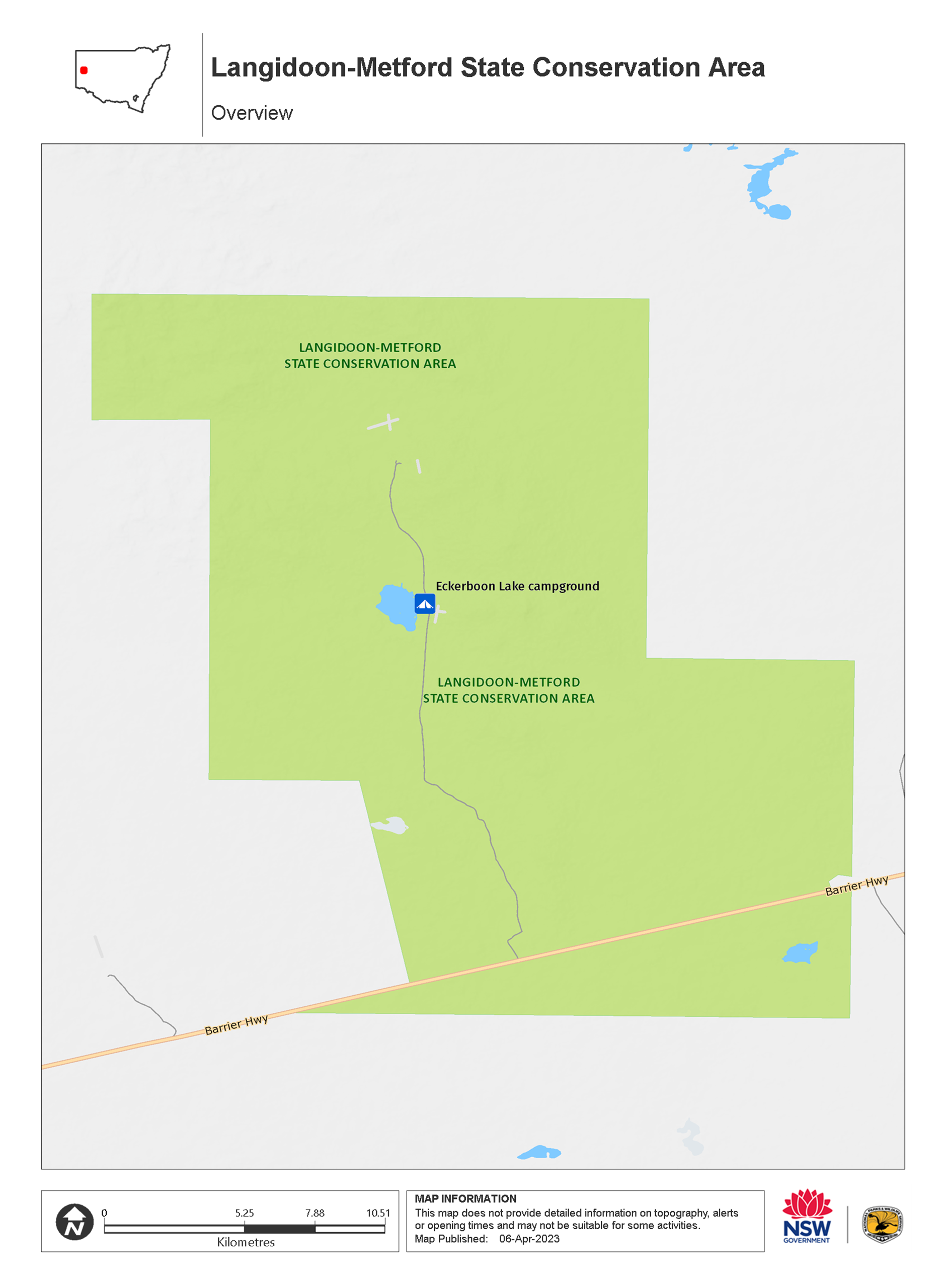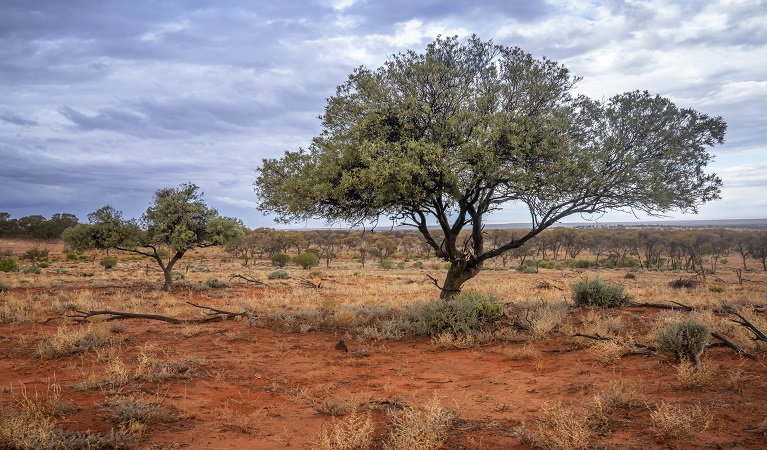Langidoon-Metford State Conservation Area
Overview
Langidoon-Metford State Conservation Area is in far west NSW, 40mins from Broken Hill and 1hr 30mins from Wilcannia. With vast open plains and great birdwatching, it's an ideal place to take a day trip or camp under the stars.
Read more about Langidoon-Metford State Conservation Area
Located about 65km from Broken Hill, Langidoon-Metford State Conservation Area offers scenic views, birdwatching and a unique opportunity to experience the exquisite beauty of Outback NSW.
Look out between the Barrier and Scopes Ranges and you'll find seemingly endless views, characteristic of Outback NSW. With its rolling hills, vast plains and wide-open sky, you'll have the opportunity to capture some stunning photographs.
Panoramic views aren't the park's only special feature though, it's also rich in native wildlife. When filled with water the ephemeral Eckerboon Lake is home to large numbers of threatened and endangered birds, including iconic species such as black swans and pelicans. As you make your way through the park, you're likely to see flocks of emus, and keep your eyes peeled at dawn and dusk for flights of pink cockatoos and parrot species nesting in shrublands. There are also vast areas of nelia shrublands, a unique and threatened ecosystem found nowhere else in such abundance within an NPWS reserve.
To complete your Outback NSW experience, history buffs can visit the remains of old houses, woolsheds and stockyards, and camping enthusiasts can enjoy an overnight stay at Eckerboon Lake campground and picnic area.
Local alerts
For the latest updates on fires, closures and other alerts in this area, see https://www.nationalparks.nsw.gov.au/visit-a-park/parks/langidoon-metford-state-conservation-area/local-alerts
Contact
- in the Outback NSW region
Langidoon-Metford State Conservation Area is always open but may have to close at times due to poor weather or fire danger.
-
-
Broken Hill office
08 8084 2880
Contact hours: Monday to Friday, 8.30am to 4.30pm. Closed 1pm to 2pm. - 183 Argent Street, Broken Hill NSW 2880
-
Email: npws.westdarling@environment.nsw.gov.au
-
Broken Hill office
Visitor info
All the practical information you need to know about Langidoon-Metford State Conservation Area.
Map

Map legend

Maps and downloads
Nearby towns
Broken Hill (65 km)
About 10 km from Broken Hill, in the middle of the Living Desert Reserve, is Sundown Hill, the site of the Living Desert Sculptures. Follow the easy walking trail that takes you past these beautiful sandstone sculptures, even more striking in this desert setting.
Wilcannia (130 km)
The small historic town of Wilcannia is located on the famous Darling River in the NSW outback. The nearby remote Mutawintji National Park offers a uniquely Australian experience, with its historic Aboriginal sites and captivating rugged desert terrain.
Learn more
Langidoon-Metford State Conservation Area is a special place. Here are just some of the reasons why:
Plants and animals protected in this park
Animals
-

Wedge-tailed eagle (Aquila audax)
With a wingspan of up to 2.5m, the wedge-tailed eagle is Australia’s largest bird of prey. These Australian animals are found in woodlands across NSW, and have the ability to soar to heights of over 2km. If you’re bird watching, look out for the distinctive diamond-shaped tail of the eagle.
-

Short-beaked echidna (Tachyglossus aculeatus)
One of only 2 egg-laying mammals in the world, the short-beaked echidna is one of the most widespread of Australian native animals. Covered in spines, or quills, they’re equipped with a keen sense of smell and a tube-like snout which they use to break apart termite mounds in search of ants.
-

Australian pelican (Pelecanus conspicillatus)
The curious pelican is Australia’s largest flying bird and has the longest bill of any bird in the world. These Australian birds are found throughout Australian waterways and the pelican uses its throat pouch to trawl for fish. Pelicans breed all year round, congregating in large colonies on secluded beaches and islands.
-

Emu (Dromaius novaehollandiae)
The largest of Australian birds, the emu stands up to 2m high and is the second largest bird in the world, after the ostrich. Emus live in pairs or family groups. The male emu incubates and rears the young, which will stay with the adult emus for up to 2 years.
-

Red kangaroo (Macropus rufus)
The red kangaroo is one of the most iconic Australian animals and the largest marsupial in the world. Large males have reddish fur and can reach a height of 2m, while females are considerably smaller and have blue-grey fur. Red kangaroos are herbivores and mainly eat grass.
Plants
-

Mulga (Acacia aneura)
Mulga are hardy Australian native plants found throughout inland Australia. With an unusually long tap root, the mulga is able to withstand long periods of drought.
-

River red gum (Eucalpytus camaldulensis)
Australian native plants, majestic river red gum trees are widespread across Australian inland river systems. The river red gum is a dominant tree species of the Murray-Darling basin which spans NSW, Queensland and Victoria. This iconic native eucalypt grows to a height of 30m and is thought to have a lifespan up to 500-1000 years.
-

Saltbush (Atriplex nummularia)
A hardy Australian native plant, the saltbush is a small spreading shrub that can withstand dry salty soils such as those found in the desert plains of western NSW. It is grey-white in colour and has small spear-shaped succulent leaves. It flowers from December to April.
-

Sturt's desert pea (Swainsona formosa)
One of Australia’s most famous desert wildflowers, Sturt’s desert pea is found across inland arid regions of Australia, including far west NSW. One of the most easily-recognised Australian native plants, Sturt’s desert pea thrives in red sandy soil, or loam, and has vibrant red leaf-shaped flowers with a black centre, known as a ‘boss’.
Environments in this park
- Desert and arid shrubland environments
- Grassland environments
- Wetland environments
- Woodland environments
What we're doing
Langidoon-Metford State Conservation Area has management strategies in place to protect and conserve the values of this park. View the detailed park and fire management documents.

